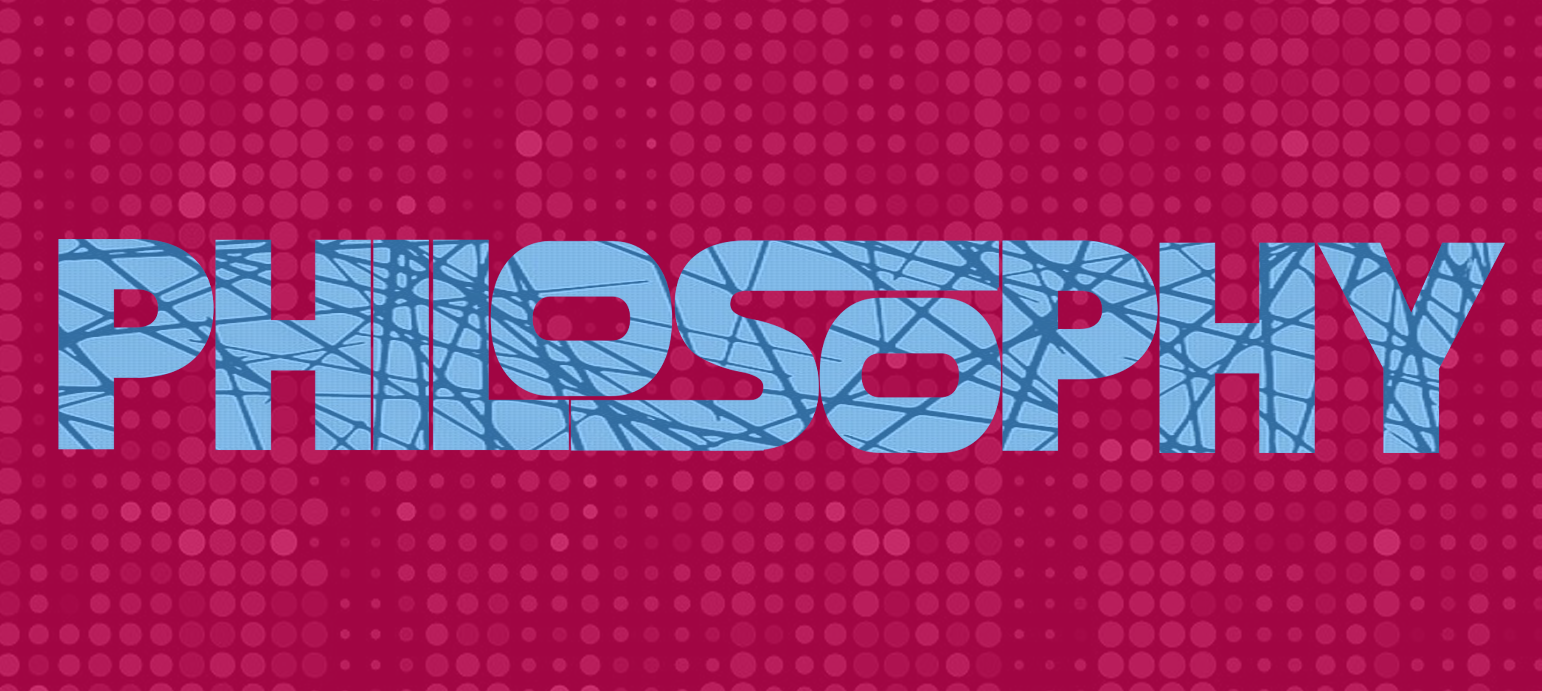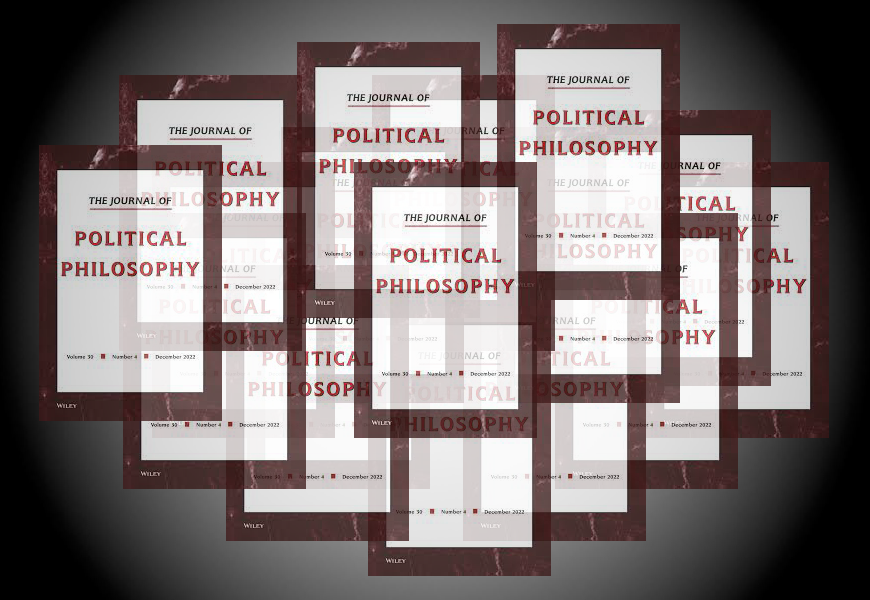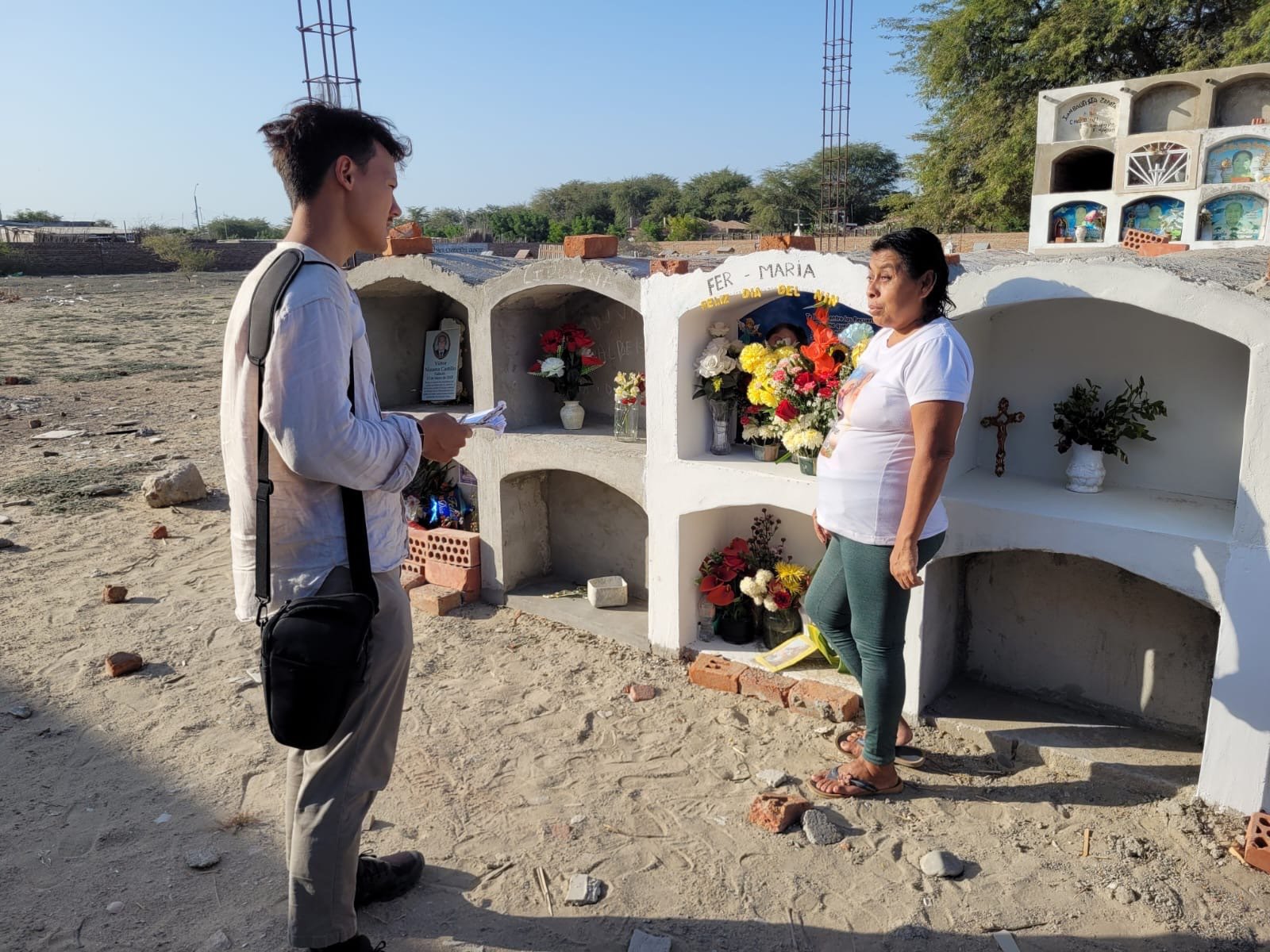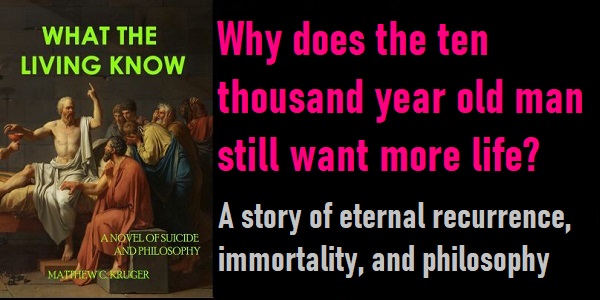Publishing
Philosophy’s Digital Future (guest post)
“The crucial question for any academic system is how filtering works. Information is cheap. What we want is some way to identify the most valuable information.”
In the following guest post, Richard Y. Chappell, associate professor of philosophy at the University of Miami, discusses how new technologies could facilitate better publication and research systems.
(A version of this post first appeared at Good Thoughts.)

Philosophy’s Digital Future:
How technology could transform academic research
by Richard Y. Chappell
Our current system for academic publishing strikes me as outdated. The ‘filter then publish’ model was designed for a non-digital world of high publication costs. Online publishing removes that constraint, enabling the shift to a superior ‘publish then filter’ model. What’s more: future advances in AI will make it easier to “map” our collective knowledge, identifying the most important contributions and highlighting gaps where more work is needed. Putting the two together yields a vision of a future academic system that seems far better suited to advancing our collective understanding than our current system.
Mapping the Literature
Imagine having access to an accurate synthesis of the academic literature, viewable at varying degrees of detail, mapping out everything from (a) the central positions in a debate, and the main arguments for and against each candidate position, to (z) the current status of the debate down to the n-th level of replies to replies to sub-objections. Such a comprehensive mapping would be far too much work for any human to do (though the high-level summaries of a debate offered in “survey” papers can be very helpful, they are inevitably far from complete, and may be tendentious). And current-generation LLMs don’t seem capable of reliably accurate synthesis. But presumably it’s just a matter of time. Within a decade or two (maybe much less), AIs could produce this mapping for us, situating (e.g.) every paper in the PhilPapers database according to its philosophical contributions and citation networks.
You could see at a glance where the main “fault lines” lie in a debate, and which objections remain unanswered. This opens up new ways to allocate professional esteem: incentivizing people to plug a genuine gap in the literature (or to generate entirely new branches), and not just whatever they can sneak past referees. This in turn could remedy the problem of neglected objections (and general lack of cross-camp engagement) that I’ve previously lamented, and encourage philosophical work that is more interesting and genuinely valuable.
Publish then filter
Suppose that your paper gets “added to the literature” simply by uploading it to PhilPapers. The PhilAI then analyzes it and updates the PhilMap accordingly. So far, no referees needed.
The crucial question for any academic system is how filtering works. Information is cheap. What we want is some way to identify the most valuable information: the papers of greatest philosophical merit (on any given topic) that are worth reading, assigning, and esteeming. Currently we rely on hyper-selective prestigious journals to do much of this filtering work for us, but I think they’re not very good at this task. Here I’ll suggest two forms of post-publication filtering that could better help us to identify worthwhile philosophy. (Though let me flag in advance that I’m more confident of the second.)
- PhilMap influence
Right now, the main numerical measure of influence is citation counts. But this is a pretty terrible metric: an offhand citation is extremely weak evidence of influence,1 and (in principle) a work could decisively settle a debate and yet secure no subsequent citations precisely because it was so decisive that there was nothing more to say.
An interesting question is whether the PhilAI could do a better job of measuring a contribution’s impact upon the PhilMap. One could imagine getting credit based upon measures of originality (being the first to make a certain kind of move in the debate), significance (productively addressing more central issues, rather than epicycles upon epicycles—unless, perhaps, a particular epicycle looked to be the crux of an entire debate), positive influence (like citation counts try to measure, but more contentful) and maybe even negative influence (if the AI can detect that a certain kind of “discredited” move is made less often following the publication of an article explaining why it is a mistake).
If the AI’s judgments are opaque, few may be inclined to defer to its judgments, at least initially. But perhaps it could transparently explain them. Or perhaps we would trust it more over time, as it amassed a reliable-seeming track record. Otherwise, if it’s no better than citation counts, we may need to rely more on human judgment (as we currently do). Still, there’s also room to improve our use of the latter, as per below.
- Crowdsourcing peer evaluation
This part doesn’t require AI, just suitable web design. Let anyone write a review of any paper in the database, or perhaps even submit ratings without comments.2 Give users options to filter or adjust ratings in various ways. Options could include, e.g., only counting professional philosophers, filtering by reviewer AOS, and calibrating for “grade inflation” (by adjusting downwards the ratings of those who routinely rate papers higher than other users do, and upwards for those who do the opposite) and “mutual admiration societies” (by giving less weight to reviews by philosophers that the author themselves tends to review unusually generously). Ease of adding custom filters (e.g. giving more weight to “reviewers like me” who share your philosophical tastes and standards) would provide users more options, over time, to adopt the evaluative filters that prove most useful.
Then iterate. Reviews are themselves philosophical contributions that can be reviewed and rated. Let authors argue with their reviewers, and try to explain why they think the other’s criticisms are misguided. Or take the critiques on board and post an updated version of the paper, marking the old review as applying to a prior version, and inviting the referee to (optionally) update their verdict of the current version. (Filters could vary in how much weight they give to “outdated” ratings that aren’t confirmed to still apply to new versions, possibly varying depending on how others’ ratings of the two versions compare, or on whether third parties mark the review as “outdated” or “still relevant”.) Either way, the process becomes more informative (and so, one hopes, likely more accurate).3
Instead of journals, anyone—or any group—can curate lists of “recommended papers”.4 The Journal of Political Philosophy was essentially just “Bob’s picks”, after all. There’s no essential reason for this curation role to be bundled with publication. As with journal prestige, curators would compete to develop reputations for identifying the best “diamonds in the rough” that others overlook. Those with the best track records would grow their followings over time, and skill in reviewing and curation—as revealed by widespread following and deference in the broader philosophical community—could be a source of significant professional esteem (like being a top journal editor today). Some kind of visible credit could go to the reviewers and curators who first signal-boost a paper that ends up being widely esteemed. (Some evaluative filters might seek to take into account reviewer track record in this way, giving less weight to those whose early verdicts sharply diverge—in either direction—from the eventual consensus verdicts.)
One could also introduce academic prediction markets (e.g. about how well-regarded a paper will be in X years time) to incentivize better judgments.
PhilMap Evaluative Filters
Combining these two big changes: users could then browse an AI-generated “map” of the philosophical literature, using their preferred evaluative filters to highlight the most “valuable” contributions to each debate—and finding the “cutting edges” to which they might be most interested in contributing. This could drastically accelerate philosophical progress, as the PhilMap would update much faster than our current disciplinary “conventional wisdom”. It could also help researchers to avoid re-inventing the wheel, focusing instead on areas where more work is truly needed. So there seem clear epistemic benefits on both the “production” and “consumption” sides.
Summary of benefits
- The entire system is free and open access.
- Users can more easily find whatever valuable work is produced, and understand the big-picture “state of the debate” at a glance.
- Valuable work is more likely to be produced, as researchers are given both (i) better knowledge of what contributions would be valuable, and (ii) better incentives to produce valuable work (since it is more likely to be recognized as such).
- A small number of gatekeepers can’t unilaterally prevent valuable new work from entering “the literature”. (They also can’t prevent bad new work. But there’s no real cost to that, as the latter is easily ignored.)
- It offers a more efficient review process, compared to the current system in which (i) papers might be reviewed by dozens of referees before finally being published or abandoned, and (ii) much of that reviewing work is wasted due to its confidential nature. My described system could solve the “refereeing crisis” (whereby too much work for too little reward currently results in undersupply of this vital academic work—and what is supplied is often of lower quality than might be hoped), thanks to its greater efficiency and publicity.5
- Disincentivizes overproduction of low-quality papers. If publication is cheap, it ceases to count for much.
- It pushes us towards a kind of pluralism of evaluative standards.6 Currently, publishing a lot in top journals seems the main “measure” of professional esteem. But this is a terrible measure (and I say this as someone who publishes a lot in top journals!). Philosophers vary immensely in their evaluative standards, and it would be better to have a plurality of evaluative metrics (or filters) that reflected this reality. Different departments might value different metrics/filters, reflecting different conceptions of what constitutes good philosophy. If this info were publicly shared, it could help improve “matching” within the profession, further improving job satisfaction and productivity, and reducing “search costs” from people moving around to try to find a place where they really fit.
Objections
Are there any downsides sufficient to outweigh these benefits?
- Incentivizing reviews
In response to a similar proposal from Heeson & Bright to shift to post-publication review, Hansson objects that “it is not obvious where that crowd [for crowd-sourced post-publication review] would come from”:
Anyone who has experience of editing knows how difficult it is to get scholars to review papers, even when they are prodded by editors. It is difficult to see how the number of reviews could increase in a system with no such prodding.
There is an obvious risk that the distribution of spontaneous post-publication reviews on sites for author-controlled publication will be very uneven. Some papers may attract many reviews, whereas others receive no reviews at all. It is also difficult to foresee what will happen to the quality of reviews. When you agree to review a paper for a journal in the current system, this is a commitment to carefully read and evaluate the paper as a whole and to point out both its positive and its negative qualities. It is not unreasonable to expect that spontaneous peer reviews in an author-controlled system will more often be brief value statements rather than thorough analyses of the contents.
An obvious solution would be to make submissions of one’s own work to the PhilMap cost a certain number of “reviewer credits”.7 Reviews of a particular paper might earn diminishing credits depending on how many reviews it has already secured. And they might be subject to further quality-adjustments, based on automatic AI analysis and/or meta-crowdsourced up/down votes. Perhaps to earn credits, you need to “commit” to writing a review of an especially substantive and thorough nature. It would be worth putting thought into the best way to develop the details of the system. But I don’t see any insuperable problems here. Further, I would expect review quality to improve significantly given the reputational stakes of having your name publicly attached. (Current referees have little incentive to read papers carefully, and it often shows.)
- Transition feasibility
Another worry is simply how to get from here to there. I think the AI-powered PhilMap could significantly help with that transition. Currently, most PhilPapers entries are traditional publications. The PhilMap doesn’t require changing that. But if/as more people (and institutions) started using evaluative filters other than mere journal prestige, the incentive to publish in a journal would be reduced in favor of directly submitting to the PhilMap. And I’d certainly never referee for a journal again once a sufficiently well-designed alternative of this sort was available: I’d much rather contribute to a public review system—I positively enjoy writing critical blog posts, after all! If enough others felt similarly, it’s hard to see how journals could survive the competition.
Of course, this all depends upon novel evaluative metrics/filters proving more valuable than mere journal prestige, inspiring people to vote with their feet. I think journals suck, so this shouldn’t be difficult. But if I’m wrong, the radical changes just won’t take off as hoped. So it seems pretty low-risk to try it and see.
- Other objections?
I’m curious to hear what other concerns one might have to the proposed system. There was some past discussion of Heeson & Bright’s proposal on Daily Nous, but I think my above discussion addresses the biggest concerns. I’ve also seen mention of a critical paper by Rowbottom, but my institution doesn’t provide access to the journal it’s in, and the author didn’t bother to post a pre-print to PhilPapers, so I can’t read their criticisms. (Further evidence that the current system is lousy!)
Notes
1. For example, my most-cited paper (on ‘Fittingness’) gets mentioned a lot in passing, but ~zero substantial engagement, whereas I get the sense that ‘Value Receptacles’ and ‘Willpower Satisficing’ have done a lot more to change how others actually think about their respective topics. (And, indeed, I think the latter two are vastly better papers.)
2. Either way, they should flag any potential conflicts of interest (e.g. close personal or professional connections to the author), and others should be able to raise flags when the reviewer themselves fails to do so. Mousing over the reviewer’s name could indicate relevant data about their track record, e.g. professional standing, average ratings that they give to others, etc.
3. Arvan, Bright, & Heesen argue that formal jury theorems support this conclusion. I’m dubious of placing muchweight on such arguments: too much depends on whether the background assumptions are actually satisfied. But their “replies to objections” section is worth reading!
4. As with reviewers, curators would need to flag any conflicts of interest (but could do whatever they want subject to offering that transparency).
5. The publicity might deter some grad students and precariously employed philosophers from offering critical reviews (e.g. of work by faculty who could conceivably be on their future hiring committee). But if fewer reviews are needed anyway, those from the securely employed may well suffice. The cowardly might also be mistaken in their assumptions: I’d expect good philosophers to think betterof candidates who can engage intelligently (even if critically!) with their work. (But who knows how many people on hiring committees actually meet my expectations for “good philosophers”. Reality may disappoint.)
A second effect of the publicity might be that everyone would be less inclined to write scathingly negative reviews, for fear of making enemies. But that’s probably a good thing. Scathing negative reports are often stupid, and would benefit from having the writers be careful of their reputations. It should always be possible to write an appropriately negative review in such a way as to cause no embarrassment from having one’s name attached to it.
Alternatively, the software might offer some way to anonymize one’s review (subject to checks to ensure that one isn’t abusing anonymity to hide a conflict of interests). Different evaluative filters might then vary in how much weight they give to anonymous vs. named reviews.
6. By this I mean a “descriptive” form of pluralism, i.e. about candidate You don’t have to think the standards are all equal; but you should probably expect other philosophers to disagree with your philosophical values. So I think it’s appropriate to have a plurality of candidate standards available, from which we can argue about which is actually best, rather than pretending that our current measure is actually reliably measuring anything in particular, let alone any shared conception of philosophical merit. (Maybe it generates a shared sense of social statusor prestige, which we all then value. But I take that to be a bad thing. It would be better for different subgroups to esteem different philosophers, who better merit it by the locally accepted standards. And for all this to be more transparent.)
7. If we want to reduce the pressure on grad students and the tenuously employed, they could be awarded a limited number of free credits each year, allowing them to submit more and review less. Conversely, the price per submission for senior faculty could increase, reflecting expectations that tenured faculty should shoulder more of the reviewing “burden”.
Related: “‘Hey Sophi’, or How Much Philosophy Will Computers Do?“
The post Philosophy’s Digital Future (guest post) first appeared on Daily Nous.
Philosophers, Should You Pay to Publish Your Paper? (guest post)
“In a survey of 27 philosophy of science journal editors we conducted in 2023, many, if not most of them, did not know that they were working in a transformative journal.” A what now?
The landscape of academic publishing is changing. In the following guest post, Sophia Crüwell (Cambridge), Chiara Lisciandra (Groningen), and David Teira (UNED) talk about the push towards Open Access, its effects, and ways it can go better and worse.

Philosophers, Should you Pay to Publish your Paper?
by Sophia Crüwell, Chiara Lisciandra, David Teira
If you have recently had a manuscript accepted by a journal published by one of the traditional subscription-focused publishers (e.g., Springer), you may have noticed a not-so-subtle change in the publication options. As part of your publishing agreement, the interface may nudge you to pay an Author Publication Charge (APC) to publish your paper Open Access. The traditional publish-for-free, behind a paywall, tick appears only in a smaller typeset link somewhere at the bottom of the screen. Why is this happening?
In November 2022, under the auspices of three major international societies in the philosophy of science, we started an inquiry to understand how we ended up here. Back then, research institutions and funding agencies on both sides of the Atlantic had decided that their scientific output should be Open Access (OA): free for everyone to read after publication. (Great! Or so it seems.) To make this happen, funding bodies and other institutions signed Transformative Agreements with publishers, paying for thousands of APCs in advance so (a) their affiliated authors could publish OA at no cost for them; and (b) journals would transition to a Gold Open Access regime, in which APCs, instead of subscriptions, would cover the journal costs.
The drawback: once the transition was completed, authors without the necessary funds may not be able to publish in the leading journals in their fields.
For the funding bodies, as Paola Galimberti explains here, transformative agreements were supposedly temporary and cost-neutral: the money previously spent in subscriptions would be invested in APCs, making research accessible to everybody. But the publishing world is changing: in 2018, 4,18 million articles were published; in 2022, the figure rose to 5,14 million. Many of these were in journals put out by new aggressive publishing houses, like MDPI and Frontiers, in which quantity often trumps quality, because their business model relies entirely on APCs: the more papers they publish, the bigger the earnings.
Recent scandals (about flawed refereeing) have shown the limitations of this approach. For traditional subscription-focussed publishers—as Ties Nijssen from Springer told us in our first panel session in Belgrade—transformative agreements were a strategy to preserve the quality and diversity of their journal portfolio. For example, Frontiers has just one big journal per field, whereas traditional subscription publishers often have many journals that specialize publishing research for a specialized community. The challenge for them was not to make the same mistakes as their new peers and risk becoming seen as predatory. There are already signs that it is not going to be easy.
In the summer of 2023, transformative agreements had their first reality check, as Sabina Leonellli laid it out for us (also in Belgrade). Very few journals had transitioned to a Gold Open Access regime: despite the subsidized APCs, most authors were still choosing to publish for free behind a paywall. This is not necessarily unreasonable: a study by Brad Wray shows that, for most papers, citations tend to be similar whether they are OA or not. cOAlition S, an alliance of EU funding bodies, decided they would not be paying subscription fees and APCs. Traditional publishers decided they would carry on with transformative journals, otherwise they would not be able to resist the competition of the more profitable ventures such as Frontiers and MDPI. This is why you, author, are finding a new interface nudging you to pay in journals where you did not expect it.
Why should this concern you?
It is already happening: Cambridge University Press is moving its leading philosophy journals to a Gold OA regime (see Episteme, here). They promise that if you do not have funds to pay APCs, there will be waivers. While this is generous, it is not guaranteed, and other publishers may not be so generous.
Many scholarly societies pay their expenses (for, e.g., conferences) through the journals they own. Publishers shared with them, as royalties, part of the money they earned via subscriptions. Now, with APCs, it remains to be seen how many journals will survive and how much money they generate for redistribution. Jim Weatherall, editor of a Cambridge journal, Philosophy of Science, explained that their current agreement between Cambridge and the PSA runs for another three years.
Meanwhile, few are noticing: in a survey of 27 philosophy of science journal editors we conducted in 2023, many, if not most of them, did not know that they were working in a transformative journal, evolving into a Gold OA regime. Publishers are seemingly not involving the key stakeholders in this conversation.
Your next question would be, we guess, what should you do about it?
If you are involved in a scholarly society, perhaps you could start a discussion about how central journals are to its mission. For instance, in response to the merger of Studies B with two other Elsevier journals, philosophers of physics have created a society that is entirely devoted to fund a new Diamond Open Access journal, Philosophy of Physics (see its editor, David Wallace, explaining it here)
In your department, you may consider supporting repositories compliant with OA principles, like Philpapers or the Phil-Sci Archive. Forget, please, about Researchgate or Academia.edu: they are for profit. Small scholarly communities like philosophy need to consolidate their own OA institutions to have an alternative if the Gold OA regime comes to prevail.
Let us find better incentives for the people bearing the hidden costs of journal publication, namely editors and reviewers. These are volunteers donating their time with no significant compensation from the publishers. Alex Levine calculated that the time he spent over the decade he edited Perspectives on Science costs $50,000 at his salary rate. That extra million papers published between 2018 and 2022 would only increase the editorial burdens, and few volunteers had an incentive to shoulder more of it. Without, e.g., teaching load reductions, extra points for service in promotion evaluation, etc., we cannot expect non-profit OA institutions to survive.
As of now, this is how the situation looks for us. We will keep reporting.
The post Philosophers, Should You Pay to Publish Your Paper? (guest post) first appeared on Daily Nous.
Notably Good Experiences with Philosophy Journals
As stories of philosophy journal horror stories continue to come in, one commenter made a suggestion.
[This post was originally published on March 3, 2021. It has been reposted by request of a reader.]

[Jim Picôt, “Love Heart of Nature” (photo of shark swimming in a heart-shaped school of salmon)]
If part of the reason for sharing such stories was to possibly reveal some common problems or patterns with an important part of the world of academic philosophy, then, says Kaila Draper, “Maybe we should have a thread about really good experiences with referees and journals so that more patterns can be detected.”
Good idea!
Readers, if you’ve had a delightful, beneficial, super-efficient, caring, understanding, or even just notably good experience with a philosophy journal, please share it.
And just to get it out of the way, while we are very happy for you, “They accepted my article!” doesn’t qualify.
The post Notably Good Experiences with Philosophy Journals first appeared on Daily Nous.
Philosophy Journal Horror Stories (updated)
By request, here is a post for people to share their journal “horror stories.”
[Originally posted March 2, 2021; reposted by request.]

Why? For one thing, it may be a relief to learn that the universe, or at least the journals, are not out to get you in particular. But also, there is the possibility, suggested by one of those making the request, that the stories, in the aggregate, reveal some patterns or issues that we can then figure out how to address.
Before we begin, now would be a good time to invoke my multi-purpose adage, “philosophers are people, too.” That includes the philosophers who are the editors of and referees for academic journals. People make mistakes, people have multiple demands on their time, people get tired, and so on. Further, these people are often volunteers or inadequately compensated, adding to their busy lives the various responsibilities of maintaining a significant portion of our professional ecosystem. So even when we may be sharing stories that reveal their imperfections, I think it is important to register appreciation for all the work they do.
UPDATE (3/2/21): A few complaints in the comments below about Pacific Philosophical Quarterly prompted a reply from Janet Levin (USC), chair of the editorial committee of the journal. In it, she writes:
We recently discovered that, due to a major error in our record-keeping process, over 100 manuscripts submitted to the PPQ over a period of a little over a year were misclassified as having undergone an initial review. There was a confluence of factors that allowed the error to go undetected for so long, some due to COVID-19, some technological, and others due to a diffusion of responsibility in the reviewing process – these factors also contributed to some failures to respond to author inquiries. When we discovered the extent of the problem we made the difficult decision to try to clear the backlog as quickly as possible, and therefore (i) to do an unusually thorough reading of papers during the internal review process to enable us to get results back to authors as quickly as possible, and (ii) not to give comments on papers that we did not send out for external review. We understand the costs of having a paper tied up at a journal for so long, and recognize the burden it places on authors waiting for a response. I take full responsibility for this unfortunate situation and apologize sincerely for our lapse. We are overhauling our processes for submission and evaluation of manuscripts to make sure not only that nothing like this happens again, but also that, going forward, the PPQ can be exemplary in giving authors quick decisions. We will announce more concrete steps in this regard soon, including a new faculty editor who will be taking over after the end of this semester.
UPDATE (3/5/21): Regarding Oxford Studies in Ancient Philosophy (mentioned in a couple of the comments below), current editor Victor Caston (University of Michigan) reports that this past October he told the journal’s publisher, Oxford University Press, that he would not be seeking to renew his contract with them when it expired. It is now expired, and Professor Caston is maintaining the journal while waiting for OUP to put a new editor or editorial team in place. See also this post at Endoxa from Caleb Cohoe (Metropolitan State University of Denver).
Note: The new comment platform appears to have carried over previous email-name affiliations. That is, it will think your name is whatever you previously used as your name when you last commented with that email address. So even if you enter in a new handle, your comment may be sent to subscribers with your old name, or if you edit your comment, it may publicly attribute that edit to your old name. In general, I encourage commenters to use their real names; so I hope that most of the time, for most people, this will not be an issue. But if you think it is important to use a pseudonym on this post, I suggest that when commenting you enter an email address you haven’t previously used here before. (Email addresses are not revealed to the public.)
Additional note about pseudonyms: as per the comments policy, pseudonyms may not contain the words “anonymous, “anon,” etc.
The post Philosophy Journal Horror Stories (updated) first appeared on Daily Nous.
Wiley’s APA Session on the Journal of Political Philosophy
“Anything they said about why this happened was at such a general level and in vague formulations, that those in the room didn’t really get any new factual information.”
That’s Ingrid Robeyns (Utrecht), writing about the session that Wiley put on at the Eastern Division Meeting of the American Philosophical Association (APA) yesterday morning about the Journal of Political Philosophy debacle (see here and here).

In a post at Crooked Timber, Professor Robeyns describes some of what occurred at the meeting. Here are some excerpts:
- “On the particular case of JPP and the firing of Bob Goodin, they didn’t really say anything, except that they “couldn’t continue working with the editor and fulfil their role as a publisher”. And when they described that role, there was lots of talk about the needs of ‘operational standardization’. Apparently, even within that small room, they could not provide details.”
- “Jonathan Quong, a member of the editorial board of JPP and now of the new journal Political Philosophy reminded Wiley that more than one thousand political philosophers had signed the petition in which they pledged not to submit, referee, or provide editorial services for the journal. So, he concluded, JPP doesn’t have a future. To which Wiley responded ‘thank you for that statement’—and that was it.”
- “Someone asked what would happen with the papers that are submitted now, given that there is no editorial team. They are received, and the authors get notified that the papers can currently not be processed. In essence, until there is a new editorial team, the papers are not being reviewed. I think under those conditions, it is unwise for anyone to submit a paper to JPP.”
- “Jonathan Quong noted that Wiley mentioned repeatedly during the meeting that they are not political philosophers and that they respect academic independence. ‘Yet how can they then appoint a new editorial team?,’ he asked. To this question, Wiley responded that they are in touch with the community, and that they are gathering advice on whom to ask for these editorial roles. No names were mentioned.”
In her post, Robeyns notes that there are legitimate concerns about publishing that are worth taking up, such as low journal acceptance rates (see here), whether journals should adopt triple-anonymous review (the new Political Philosophy will be sticking with double-anonymous review), and “that it’s really hard to publish on some topics in political philosophy in the journals that we have, such as nonwestern political philosophy.” But, she says, such concerns, and whatever criticisms there might have been about how the old Journal of Political Philosophy was run, “we must not let that be used as ammunition by Wiley to let them get away with what they did.”
Read her full post here.
The post Wiley’s APA Session on the Journal of Political Philosophy first appeared on Daily Nous.
My experience with geopolitics of knowledge in political philosophy so far
Geopolitics of knowledge is a fact. Only few (conservative) colleagues would contend otherwise. Ingrid Robeyns wrote an entry for this blog dealing with this problem. There, Ingrid dealt mostly with the absence of non-Anglophone colleagues in political philosophy books and journals from the Anglophone centre. I want to stress that this is not a problem of language, for there are other centres from which we, philosophers from the “Global South” working in the “Global South”, are excluded. In political philosophy, the centre is composed of the Anglophone world and three European countries: Italy, France, and Germany. From my own experience, the rest of us do not qualify as political philosophers, for we are, it seems, unable to speak in universal terms. We are, at best, providers of particular cases and data for Europeans and Anglophones to study and produce their own philosophical and universal theories. I think most of you who are reading are already familiar with the concept of epistemic extractivism, of which this phenomenon is a case. (If not, you should; in case you don’t read Spanish, there is this).
Critical political philosophy is one of the fields where the unequal distribution of epistemic authority is more striking. I say “striking” because it would seem, prima facie, that political philosophers with a critical inclination (Marxists, feminists, anti-imperialists, etc.) are people more prone to recognising injustice than people from other disciplines and tendencies. But no one lives outside a system of injustice and no one is a priori completely exempt from reproducing patterns of silencing. Not even ourselves, living and working in the “Global Southern” places of the world. Many political philosophers working and living in Latin America don’t even bother to read and cite their own colleagues. This is, to be sure, a shame, but there is a rationale behind this self-destructive practice. Latin American scholars know that their papers have even lesser chances of being sent to a reviewing process (we are usually desk-rejected) if they cite “too many” pieces in Spanish and by authors working outside of the academic centre.
In many reviews I’ve received in my career, I have been told to cite books by people from the centre just because they are trending or are being cited in the most prestigious Anglophone journals, even if they would contribute nothing to my piece and research. I have frequently been told by reviewers to give more information about the “particular” social-historical context I am writing from because readers don’t know a lot about it. This is an almost verbatim phrase from a review I got recently. I wonder if readers of Anglophone prestigious, Q1 journals stop being professional researchers the instant they start reading about José Carlos Mariátegui or Argentina’s last right-wing dictatorship. Why can’t they just do the research by themselves, why should we have to waste characters and words to educate an overeducated public? This is as tiresome as it is offensive. When I cite the work of non-Anglophone authors from outside of the imperial centres (UK, USA, Italy, Germany, and France, no matter the language they use to write), reviewers almost always demand that I include a reference to some famous native Anglophone (or Italian / German / French, without considering gender or race; the power differential here is simple geographical procedence) author who said similar things but decades after the authors I am quoting. I’ve read all your authors. Why haven’t they read “mine”? And why do they feel they have to suggest something else instead of just learning about “our” authors? This is what I want to reply to the reviewers. Of course, I don’t. I dilligently put the references they demand. I shouldn’t have to, but if I don’t, I don’t get published. There’s the imperial trick again.
English is also always a problem, but not for everyone who is not Anglophone. In 2020 I was in London doing research at LSE. I attended a lecture by a European political theorist. They gave the talk in English. Although they work at a United Statian University, their English was poor. The room was packed. The lecture was mediocre. I was annoyed. “Why do they feel they don’t have to make an effort to pronounce in an intelligible way?”, I thought. When I speak they don’t listen to me like that, with concentrated attention and making an effort to understand me. The reason is in plain view: coloniality of power. If you come from powerful European countries, you don’t need to ask for permission. You don’t need to excel. You don’t need to have something absolutely original to say. You just show up and talk. If you are from, let’s say, Argentina, and you work there (here), you have to adapt to the traditional analytic way of writing and arguing so typical in Anglophone contexts, including citing their literature, if you want to enter the room in the first place. You are not even allowed to use neologisms, although the omnipresent use of English as a lingua franca should have already made this practice at least tolerated. One cannot expect everyone to speak English and English to remain “English” all the same. Inclusion changes the game, if it doesn’t, then it is not isegoria what is going on but cultural homogenisation. (Here is a proposal for inclusive practices regarding Enlgish as a lingua franca). The manifest “Rethinking English as a lingua franca in scientific-academic contexts” offers a detailed critique of the idea and imposition of English as a lingua franca. I endorse it 100 %. (Here in Spanish, open access; here in Portuguese).
In my particular case, I am frequently invited to the academic centre, sometimes to write book chapters, encyclopaedia entries, and papers for special issues, sometimes to give talks and lectures. Not once have I not thought it was not tokenism. Maybe it is my own inferiority complex distorting my perception of reality, but we know from Frantz Fanon which is the origin of this inferiorisation.
I used to be pretty annoyed by this whole situation until I realised that I don’t need to try to enter conversations where I am not going to be heard, understood, or taken seriously. The fact is that we don’t need to be recognised as philosophers by those who willingly ignore our political philosophy. And this is why it is hard for me to participate in forums such as this blog. I just don’t want to receive the same comments I get when I send a paper to an Anglophone, Q1 journal, to put it simply.
But I also want to keep trying, not to feel accepted and to belong, but because I do believe in transnational solidarity and the collective production of emancipatory knowledge. It is a matter of recognition, and a question of whether it is possible for the coloniser to recognise the colonised, to name Fanon once more.
Our Editors Discuss Solutions and Storytelling
As part of our winter membership drive, we are pulling back the curtain on what we do here at Reasons to be Cheerful. This is part three of a three-part series. You can find part one here and part two here. In this final installment, we bring you a conversation between Executive Editor Will Doig and Editorial Director Rebecca Worby about growing awareness of solutions journalism and what makes stories resonate. Want to learn more about our membership program? Click here.
Rebecca Worby: In the early days of RTBC, there was much less awareness about solutions journalism. How has awareness grown since RTBC launched?
Will Doig: A lot of big publications have added a section specifically for solutions stories in the last few years — like the New York Times section Headway — and then some of those stories get filtered onto the homepage. From the reader’s perspective, these stories might not even register as “solutions journalism” since they’re positioned as just another news story, which is exactly how they should be treated, in my opinion.
WD: What makes a RTBC story a RTBC story?
RW: A RTBC story will tell you not just what the solution to a problem is, but how that solution was implemented. Ideally, it’ll do that in a way that feels conversational and approachable: You don’t need to be an expert on sustainable timber construction to understand and enjoy a story about the Portland airport’s new wooden roof.
 In November, Hannah Wallace reported for us about the Portland airport’s new sustainable timber roof. Courtesy of Port of Portland
In November, Hannah Wallace reported for us about the Portland airport’s new sustainable timber roof. Courtesy of Port of Portland
At its best, a RTBC story is truly a story — that is, a narrative that you want to read from start to finish. Our stories may not always be as cheerful as the name suggests, but they do tend to be upbeat, and I hope they give the reader a sense of hope and buoyancy.
RW: What types of stories do you find that our audience is most drawn to?
WD: Climate, the environment, green energy — these have been our most popular topics since day one. They’re not only huge issues that affect everyone, they’re awash in promising solutions that often have a good narrative behind them.
Crushed by negative news?
Sign up for the Reasons to be Cheerful newsletter.
[contact-form-7]
We saw a jump in interest in social justice stories during and after the 2020 protests, but because those solutions often aren’t as cut and dry, I think it’s harder for readers to walk away from them with a feeling that something has been solved. They might sometimes feel like they’re describing incremental progress in an intractably unfair world.
WD: What’s a common misconception about solutions journalism or RTBC?
RW: When people hear the name Reasons to be Cheerful, or when they hear about solutions journalism more generally, some might leap to the conclusion that our stories are all light and fun — or, worse, that we’re sugar-coating the truth. But our stories are always rigorously reported, and they don’t shy away from the negative when necessary. For example, we strive to always address not just what’s working well with a particular solution, but also the limitations or challenges it faces.
WD: What’s a story from this year that really resonated with our readers and why do you think it did?
RW: Contributing Editor Peter Yeung’s story about what Barcelona is doing to deal with overtourism was among our most popular this year. It came out in the middle of the summer, a time when a lot of readers are traveling (or dreaming of their next trip), and it spoke to an issue that a lot of us have experienced first-hand: What happens when a beloved place is, well, loved a little too much?
Interestingly, it’s not the most cut-and-dry solution story — as Peter writes, improvements in the impacts of tourism are tough to quantify — but I think there’s something satisfying about learning what a historic, beautiful city is doing to preserve itself.
 Park Güell, designed by Antoni Gaudí, is a UNESCO World Heritage Site one of Barcelona’s most popular tourist attractions. Credit: dvoevnore / Shutterstock
Park Güell, designed by Antoni Gaudí, is a UNESCO World Heritage Site one of Barcelona’s most popular tourist attractions. Credit: dvoevnore / Shutterstock
RW: What’s a story from our archives that you still find yourself thinking about a lot?
WD: In 2020 our writer Klaus Sieg wrote about Berlin’s effort to incentivize residents to buy things used instead of new, and to repair their stuff instead of throwing it away. It was technically a story about policies that encourage reuse, but what it was really about was an entire city — from its government agencies on down to its residents — transforming its mindset around wasteful, consumption-oriented lifestyles.
RW: One of the first things I edited for RTBC was Elizabeth Hewitt’s story about “beaver dam analogues” in Colorado. Essentially, human impacts have degraded ecosystems — in this case, by wiping out beaver populations — and now humans are mimicking nature to try to restore those ecosystems and make them more adaptable to climate change. It’s a low-tech solution, and one that could ultimately help welcome beavers back to these places. I love when a solution is about undoing damage and helping nature do its thing.
RW: What’s a response from a reader that has stayed with you or impacted your thinking about the work that we do?
WD: We get a lot of notes from teachers who say they use Reasons to be Cheerful in their classrooms, which is really gratifying. One specific response that’s always stuck with me was from a soldier in a war zone who said he reads us to avoid losing hope — even though that’s just one person, it feels like a big impact.


Become a sustaining member today!
Join the Reasons to be Cheerful community by supporting our nonprofit publication and giving what you can.
RW: I really appreciate the notes from teachers, too. I also enjoy hearing from folks whose life or work is closely tied to something we’ve covered. One of our writers recently told us that her mother was sharing Michaela Haas’ article about “The Power of Sharing Patients’ Life Stories With Caregivers” with all her friends. Old-fashioned word-of-mouth — I loved hearing that.
RW: A lot of online magazines struggle, and many shrank or disappeared after the pandemic, but RTBC just keeps growing. Why do you think this is?
WD: I think our name helps — we have a newsletter that has over 130,000 subscribers and being able to drop something that literally says “Reasons to be Cheerful” into someone’s inbox once a week almost feels like cheating.
Aside from that, I think the hunger for this type of journalism is real. There’s more of it than there used to be, but clearly not enough. We also just work really hard to make every story as good as it can possibly be, so maybe there’s an element of quality winning the day, as well.
The post Our Editors Discuss Solutions and Storytelling appeared first on Reasons to be Cheerful.
How Solutions Journalism Is Sparking Change
As part of our winter membership drive, we are pulling back the curtain on what we do here at Reasons to be Cheerful. In this story, Contributing Editor Peter Yeung explores the evolution of solutions journalism and what we know about its impacts. This is part two of a three-part series. Click here to read part one and here to read part three. Want to learn more about our membership program? Click here.
When Karen McIntyre began her PhD at the University of North Carolina at Chapel Hill in 2012, she had never heard of solutions journalism. But one day a professor asked her to compile a list of “positive news” websites for a media research project.
“What I initially found was not solutions journalism at all,” says McIntyre. “It was good news journalism. Happy news. ‘Fireman saves cat’ kind of news.”
But later, while carrying out that research McIntyre came across the idea of “serious news done in a constructive way” — and her curiosity spiked. For her, it was the polar opposite of the media industry’s status quo: rather than agonizing superficially over the negatives of the day, this was about scrutinizing how and why things went right.
 Earlier this year, Yeung traveled to Lima, Peru to report on a surf therapy scheme. Courtesy of Peter Yeung
Earlier this year, Yeung traveled to Lima, Peru to report on a surf therapy scheme. Courtesy of Peter Yeung
“It was a breath of fresh air,” says McIntyre, who then channeled her energies into finding out as much about this nascent practice as she could.
But there was little out there. In fact, she could find no academic research about the field at all. So in 2015, McIntyre published her dissertation analyzing the positive psychological effects of “constructive journalism” and “solution information” on the readers of news stories — to her knowledge, the first scientific research of its kind.
“These days there’s so much more research out there,” adds McIntyre, who is now an associate professor of journalism at Virginia Commonwealth University. (A list compiled by her colleague Kyser Lough contains 246 pieces of research to date.)
Ever since its beginnings, the journalism industry has sought to change society for the better and pick apart the merits and pitfalls of policies and projects around the world. Yet a fast-expanding movement is transforming the industry by promoting an approach to journalism centered on assessing responses to society’s problems – from the climate emergency to plastic waste, gender inequality and cultural division.
Advocates argue there’s an urgent need to reform the media amid a crisis of financial sustainability, plummeting trust, societal disharmony and a wider failure of journalism to serve the public interest. A survey by Pew Research in 2021 found 42 percent of US adults have no trust in information from national news organizations (up from 35 percent in 2019). More recently, the Reuters Institute 2023 digital news report, a survey of 93,000 people (who identify as news consumers) across 46 countries by Oxford University, found that 36 percent say they also often or sometimes actively avoid the news.
!function(){"use strict";window.addEventListener("message",(function(a){if(void 0!==a.data["datawrapper-height"]){var e=document.querySelectorAll("iframe");for(var t in a.data["datawrapper-height"])for(var r=0;r
The solution? It’s complicated. But, aptly enough, solutions journalism could play a significant role.
“There are no simple solutions to what is a multifaceted story of disconnection and low engagement in a high-choice digital environment, but our data suggest that less sensationalist, less negative and more explanatory approaches might help, especially with those who have low interest in news,” the Reuters Institute report concluded.
In fact, a separate Reuters Institute survey of 303 media executives from 53 countries in January 2023 found that 73 percent of those leaders planned to publish more solutions and constructive journalism in the future in order to combat so-called “news avoidance.”
Crushed by negative news?
Sign up for the Reasons to be Cheerful newsletter.
[contact-form-7]
Professor McIntyre describes solutions and constructive journalism as two strands of a kind of “socially responsible” reporting. They both aim to remedy “news fatigue and perceived negativity bias,” she says, and together represent a shift away from conventional, “just the facts”-style reporting to a more contextual approach, where “journalists consider the bigger picture and play a more interpretive role.”
Two organizations have been at the heart of this emerging movement: The Solutions Journalism Network (SJN), a US-based nonprofit that was established in 2013, and the Constructive Institute, which was founded in 2017 and is based at Denmark’s Aarhus University.
!function(){"use strict";window.addEventListener("message",(function(a){if(void 0!==a.data["datawrapper-height"]){var e=document.querySelectorAll("iframe");for(var t in a.data["datawrapper-height"])for(var r=0;r
While interpretations vary, solutions journalism reporting tends to follow the four pillars defined by the SJN: the response to a problem; insight learned from that response; evidence showing the response works; and an analysis of the response’s limitations. The wider-ranging constructive journalism includes solutions journalism as one of its components, but also should include multiple perspectives. A constructive journalism story is framed on the positive rather than negative aspects of communities involved and attempts to eschew simplicity in favor of nuance.
“Solutions and constructive journalism are different, but they fit together very well,” says Lisa Urlbauer, head of the journalism training programs at the Bonn Institute, a German nonprofit focused on constructive journalism that launched in March 2022. “They have this idea that we must put people’s needs at the heart of our journalism.”
There’s no doubt that there’s been a huge shift towards solutions-focused reporting. In recent years, the New York Times has launched Headway, an initiative “exploring the world's challenges through the lens of progress” and the Washington Post has created a section dedicated to climate solutions. In April, the New Yorker ran a special edition on climate solutions, and in October, NPR dedicated an entire week of coverage to solving the climate crisis. Publications such as NextCity, Grist and Mongabay have announced shifts towards solutions reporting, the last of which is launching a dedicated solutions desk. Meanwhile, Reasons to be Cheerful, one of the world’s first and few solutions journalism-only outlets, has been in action since 2019.
More concretely, the SJN’s story tracker page, a non-exhaustive list of stories that adhere to its pillars of solutions journalism, contains 15,600 articles that have been vetted internally. In addition, the network says it has trained 47,000 journalists across North America, Europe, Africa and Latin America, partnering with news organizations and journalism schools to help encourage the take-up.
“The industry has taken pretty huge steps generally,” says Allen Arthur, a solutions reporter and author of the SJN’s flagship newsletter Above the Fold.
 In Northern Peru, Yeung reported on a deadly outbreak of dengue fever (and responses to it). Courtesy of Peter Yeung
In Northern Peru, Yeung reported on a deadly outbreak of dengue fever (and responses to it). Courtesy of Peter Yeung
Arthur, who often writes about and works with formerly incarcerated people, was himself hugely influenced by the new approach to reporting. “I had never thought about changing the whole structure of the story itself,” he says. “Instead I realized I could do journalism to help a community reach its goals and navigate obstacles.”
The Bonn Institute, whose initiative is centered on a close partnership with German media outlets including national broadcaster Deutsche Welle, characterizes that shift as a kind of Journalism 2.0 that should be the industry norm.
“It’s a second wave of digitization,” says Urlbauer. “For us, fostering better debate is a more modern kind of reporting. There are many people in society who do not feel adequately heard by mainstream journalism, and we need to broaden our approach.”
However, while investment into the approach has ramped up massively, the evidence of solutions and constructive journalism’s impact is less clear-cut.
For one, the goals of the movement are various and subject to debate: to build trust, to create a more inclusive industry, to catalyze the uptake of successful solutions, to counteract stereotypes, to improve readers’ mental health, to reduce polarization and division in society, or perhaps to make the media more financially sustainable. What research there is has tended to be low-level in scope or focused only on certain areas.
“In every experiment that has been done in English that we could find, there was a significant impact on audiences’ emotions,” says McIntyre, who published a review of the literature involving experiments on solutions journalism in August. “They make people more positive or less negative. That was clear.”
!function(){"use strict";window.addEventListener("message",(function(a){if(void 0!==a.data["datawrapper-height"]){var e=document.querySelectorAll("iframe");for(var t in a.data["datawrapper-height"])for(var r=0;r
While those findings are useful, they are limited. In fact, 17 of 22 studies McIntyre analyzed focused on the emotional impact of solutions journalism. Only one looked at the impact of solutions journalism on trust. But for many practitioners, the goal of solutions journalism is not to be “feel-good” or “positive” — but rather to create change.
“Solutions journalism is not good news per se,” says Arthur. “It is not this big wonderful, happy ending. It should be something we can learn from.”
Small-scale research commissioned by the SJN in 2020 found that of the 628 people surveyed across the US, 51 percent said they prefer “solution” stories compared to the 32 percent who prefer “problem” stories and the 17 percent with no preference. Eighty-three percent of respondents said they trusted a solutions journalism story they viewed, compared to 55 percent who said the same about the problem-focused story.
However, the limits of the research does not mean a tangible difference isn’t being made. In fact, McIntyre argues there’s little evidence that the approach doesn’t work, whereas more and more outlets are taking it up and there are many examples of solutions reporting creating impact. “I’m not really seeing negatives,” she says. “We have reason to say that solutions journalism is useful and beneficial.”
More recent findings have also responded to some of those concerns. A study of 348 US undergraduate students by the University of Maryland last year found exposure to solutions journalism was “positively associated” with the increased likelihood to support collective action to fight for better policy. Other research has found it has improved coverage of gender violence and immigrants as well as conflict reporting.
The SJN also recently launched an Impact Tracker containing numerous, robust examples of how solutions reporting has led to change – from encouraging authorities to replicate schemes pioneered elsewhere to millions of dollars of donor support for organizations implementing solutions.
Perhaps a more significant hurdle, however, is the fact that almost all of the research is focused in the Global North: 64 percent of research identified by McIntyre was based in North America and Europe. And that is reflective of overall adoption of and support for solutions reporting — with far less development in Latin America, Africa and Asia.
“Constructive journalism has gained a foothold in Africa but it’s not mainstream yet – far from it,” says Joy Muthoni, a Kenyan academic who analyzed the uptake of constructive journalism in Kenya for her PhD. “Journalists in Africa simply haven’t had the time and resources and training to properly adopt it yet.”


Become a sustaining member today!
Join the Reasons to be Cheerful community by supporting our nonprofit publication and giving what you can.
The SJN’s Africa Initiative, which launched in 2020 to provide training and support to 60 African newsrooms including Nigeria Health Watch, has attempted to address that imbalance. And it has successfully led to nuanced reporting on vaccinations, malnutrition, sexual health, and more across Kenya, Nigeria, Rwanda and Uganda.
But Muthoni believes that model is a tricky tightrope to walk.
“I would be as bold to say that the trajectory of constructive journalism in the East African context is solely being driven by Western organizations,” she says. “That can be problematic in many ways. It’s like a new form of colonialism.”
Nonetheless, Muthoni believes that the continent would benefit from a constructive and solutions-oriented approach to journalism – following in the footsteps of the African philosophy of Ubuntu (the idea of shared humanity) as well as the history of development and peace journalism in previous decades. “But this isn’t something that happens overnight,” she says.
The SJN’s Arthur also admits there’s a long way to go when it comes to addressing the broader ingrained reporting methods such as “horse-race” coverage of political elections, focusing on candidates rather than issues that affect voters, and the fact that “terrible news will almost always be the lead items and win all of the awards.”
A decade on from its foundation, however, the SJN has undoubtedly played a role in “systematizing and supercharging” solutions journalism, as Arthur puts it — and in November the nonprofit announced its first-ever awards, representing another key landmark in the effort to make journalism more valuable, kind and impactful.
“We don’t know how solutions journalism is going to grow and evolve in the next decade,” says Arthur. “But I think the quality of stories is getting better and better and the practice is growing in incredible ways.”
The post How Solutions Journalism Is Sparking Change appeared first on Reasons to be Cheerful.
The Future of Philosophy Journals
“What is the future of philosophy journals?”

That’s the question at the heart of an upcoming open online event taking place on Wednesday, January 17th.
“The Future of Transformative Journals in Philosophy” is organized by the Open Access working group—Sophia Crüwell (Cambridge), Chiara Lisciandra (Utrecht), and David Teira (UNED). They write:
Many publishers (like Springer or Elsevier) have declared their journals “transformative”, hoping to transition to a Gold Open Access regime, in which all papers will be freely accessible, since their authors will have covered the costs with an Author Processing Charge. But while opening access to scientific publications enables a wider circulation of scientific work, this might come at the cost of hindering access to scientific contributions from authors, institutions, or countries with limited funding opportunities. European funding bodies, like the Coalition S, are now surveying the scientific community to grasp its views on this process.
The 90 minute session will have a quick introductory overview of the situation, delivered by an expert librarian, followed by a panel discussion with four journal editors and an open debate with the participants. Throughout the discussion, we will reflect on the steps to take in response to current challenges, our options as editors, and prospects for developing alternative publishing models. Overall, the session will provide a critical examination of the evolving landscape of academic publishing in philosophy.
More information and registration are here.
The post The Future of Philosophy Journals first appeared on Daily Nous.
How I Got Hooked on Solutions Journalism
As part of our winter membership drive, we are pulling back the curtain on what we do here at Reasons to be Cheerful. In this story, Contributing Editor Michaela Haas shares her perspective on solutions journalism. This is part one of a three-part series. Click here to read part two. Read part three here. Want to learn more about our membership program? Click here.
At the turn of this century, New York Times reporter Tina Rosenberg had uncovered a massive scandal but couldn’t convince her editor to publish her research: The price for HIV medication had soared. Thousands of patients in the Global South were dying because they could not afford the expensive treatment. “What people didn’t know was that the Clinton administration was colluding with the pharma industry to keep the prices artificially inflated,” the Pulitzer Prize-decorated Rosenberg says. Her editor at the New York Times Magazine agreed that the practice was scandalous but still, he was not willing to “print yet another depressing AIDS story!”
Rosenberg didn’t give up. Instead, she wrote a feature about a country that defied the pressure, produced the life-saving medication in its own labs and distributed it for free, effectively halving the death rate: Brazil.
The success of that New York Times cover story, “Look at Brazil,” was phenomenal: The US government changed its policy and the life-saving antiretrovirals became affordable in the global South. “This is exactly the principle,” Rosenberg said at a conference of the Solutions Journalism Network in Sundance, Utah, where I first met her: “Instead of just calling out a problem, we ask: Who does it better?”
Rosenberg suspected that the solutions principle would make sense for other topics, too. “The idea is too good to keep it to ourselves,” her colleague David Bornstein agreed, and in 2013, they co-founded the New York-based Solutions Journalism Network (SJN), which offers training and support for solutions journalism.
A little over five years ago, SJN retweeted a story of mine about finding post-traumatic growth. I had to look up what the network stood for. On its website, I read its definition of solutions journalism as “rigorous and compelling reporting about responses to social problems.” I was instantly hooked. It’s an evidence-driven approach that focuses on reproducible, effective solutions while not shying away from revealing limitations and shortcomings.
 “I honestly don’t think I would still be passionate about my job if I mainly wrote about what’s wrong with the world,” Haas writes. Credit: Gayle M. Landes
“I honestly don’t think I would still be passionate about my job if I mainly wrote about what’s wrong with the world,” Haas writes. Credit: Gayle M. Landes
Shortly after, I began training in solutions journalism, started writing a solutions column for the German newspaper Süddeutsche Zeitung and coordinated a local solutions journalism community in Los Angeles before joining Reasons to be Cheerful as contributing editor in the spring of 2021.
Reasons to be Cheerful is one of only a handful of publications that exclusively publishes true solutions journalism. As a reader, you might have initially come here for the “cheer” in the name, and you might not necessarily have heard of solutions journalism. But if you read us, you know you won’t find cute kitten videos on our site to cheer you up (though there is nothing cuter than kittens).
Often, solutions journalism isn’t exactly “good” news. “Journalists are not interested in making people feel good,” Bornstein agrees. “In fact, when you look at a lot of solutions journalism, it’s not designed to make people feel better. It’s almost always stories about people who are performing poorly with problems compared to how they could be performing. It makes negligence egregious because there are other options. We think it is the most powerful way to shift journalism because accountability is our number-one job.”
The negativity bias has been well documented, including in one of my favorite books, the bestseller Factfulness by the late Hans Rosling: Readers believe the world is worse than it actually is. “When asked simple questions about global trends ― what percentage of the world’s population live in poverty; why the world’s population is increasing; how many girls finish school ― we systematically get the answers wrong,” Rosling and his co-authors find. “So wrong that a chimpanzee choosing answers at random will consistently outguess teachers, journalists, Nobel laureates, and investment bankers.”
No matter which pressing problems I think of, there are always people, communities or institutions who are working to solve them, and it is simply good journalism to research them. Solutions journalism fails when it is naïve and pollyanna-ish, but it does make me feel better to know that we live in a world where smart people who care are looking for solutions.
“If we only ever write about how people fail, it’s no surprise they don’t want to read us anymore,” Bornstein adds. “It makes you feel less helpless to live in a society where people are thinking about doing better.”


Become a sustaining member today!
Join the Reasons to be Cheerful community by supporting our nonprofit publication and giving what you can.
That’s why I’m convinced that solutions journalism is also a solution for the trust crisis in journalism. According to the latest comprehensive Digital News Report by the Reuters Institute, only four out of ten news consumers say they trust most news most of the time, and more than a third (36 percent) of news consumers say they avoid the news often or sometimes. News avoiders are more likely to say they are interested in solutions-based journalism.
“Journalism suffered an existential crisis along with its economic crisis, and solutions journalism is a way of responding to that, a way of increasing trust,” Rosenberg says. “People are assuming that trust is a function of accuracy, and we think it’s also a function of people feeling seen and respected by how the media portrays them.”
Studies show that solutions reporting rarely increases click rates but it increases the reading time by 10 to 20 percent, strengthens credibility and boosts reader engagement. Karen McIntyre, professor for multimedia journalism at the Virginia Commonwealth University, discovered that solutions journalism is also an antidote to feeling helpless and hopeless.
What began in Bornstein’s one-bedroom New York apartment a decade ago has now become an international network. SJN has trained more than 47,000 journalists in 160 countries, and curates a searchable database with solutions stories from 1,900 news organizations.
“People want more solutions journalism [with a focus on the climate crisis],” writes Mitali Mukherjee, who co-authored Reuters’ report on climate news use. “And essentially, that means that they’re looking for not just positive stories, but they’re looking for what’s working in a community and what might be replicated in another.”
What I personally appreciate most about this kind of solutions-focused journalism is its impact. I continue to be amazed how the stories change me and the readers.
After I wrote about the pesticide use and labor abuse in the flower industry, I stopped buying red roses for my spouse.
After I researched an in-depth feature on the climate diet (here’s a piece about the topic by my colleague Peter Yeung), I pivoted to plant-based meals.
Since I wrote about solutions for the increase in pedestrian deaths in the US, I approach crosswalks much more carefully.
I am a reporter, not an advocate. I won’t tell you what to make for dinner or who to vote for. But once we have all the facts clearly laid out with compelling evidence, it’s nearly impossible to ignore them.
I know this is the case for you, too, because you tell me so. Since focusing on solutions journalism, I’m getting significantly more mail from readers, and 99 percent of the people who write are genuinely engaged, interested, asking good questions or requesting more information so they can adopt an idea themselves. It’s fascinating and enriching! Very rarely do I get a letter that is insulting, and I believe this is also proof that we have earned your trust.
Crushed by negative news?
Sign up for the Reasons to be Cheerful newsletter.
[contact-form-7]
Also, it’s just simply more fun and more meaningful for me to interview people who actively tackle climate change/pollution/mental health/biodiversity or any number of issues I care about. “As a journalist who is often disturbed by the sad stories that make the news daily, it comes as a relief to do something different — tell stories of hope that illuminate a gloomy world,” freelance solutions reporter Olayide Oluwafunmilayo Soaga shared on Solutions Journalism Day.
I have been a reporter since I was 16 years old, writing stories about local politics and art reviews for my local paper after school. I honestly don’t think I would still be passionate about my job if I mainly wrote about what’s wrong with the world.
Also, in the last 20 years, I’ve lived in Europe, Asia and the US. I feel this is an advantage for solutions journalism because I have seen for myself how different countries grapple with problems that other countries have been able to solve. Switzerland has the lowest abortion rate in the world, Sweden recycles more glass (94 percent) than any other country, some countries have found solutions for rising gun deaths. Which means: Your country or community can solve the issue, too.
Bornstein sees solutions journalism as a way of shedding light on what’s possible, and maybe even changing what we see as possible. He quotes the saying that sunlight is the best disinfectant before adding, “Maybe it isn’t enough to shine a light on shortcomings, maybe journalism shouldn’t just play the role of disinfectant, but also photosynthesis.”
And that is a reason to be cheerful.
The post How I Got Hooked on Solutions Journalism appeared first on Reasons to be Cheerful.

